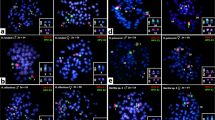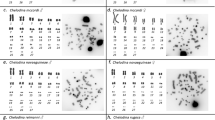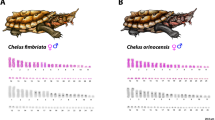Abstract
THE chromosomes of the killifish1–3 family Cyprinodontidae are being studied in many laboratories and the karyotypes of forty-eight of the approximately eighty-five species of North American killifishes have so far been determined (refs. 2 and 3 and our unpublished results), twenty-seven of them by us. All but three of the fifteen or sixteen North American genera of the family have been studied, and of the largest genera, Fundulus (twenty-nine species) and Cyprinodon (about twenty species), twenty-two and thirteen species, respectively, have been karyotyped. The diploid chromosome number of American killifishes is usually 48. The known exceptions are species of the genus Fundulus3,4 and Lucania parva (46), L. interioris (36) and Adinia xenica (32). The latter three species have large metacentric chromosomes indicating centric fusions; they can be enumerated by subtracting the total number of chromosomes from 48. For example, Adinia has sixteen large metacentrics, the thirty-two chromosomes being subtracted from 48.
This is a preview of subscription content, access via your institution
Access options
Subscribe to this journal
Receive 51 print issues and online access
$199.00 per year
only $3.90 per issue
Buy this article
- Purchase on Springer Link
- Instant access to full article PDF
Prices may be subject to local taxes which are calculated during checkout
Similar content being viewed by others
References
Scheel, J., Rivulins of the Old World (TFH Publications, New Jersey, 1968).
Chen, T. R., and Ruddle, F. H., Chromosoma, 29, 255 (1969).
Setzer, P. V., Trans. Amer. Fish. Soc., 99, 139 (1970).
Chen, T. R., Chromosoma (in the press).
McPhail, J. D., and Jones, R. L., J. Fish. Res. Board Canada, 23, 767 (1966).
Ebeling, A. W., and Chen, T. R., Trans. Amer. Fish. Soc., 99, 131 (1970).
Chen, T. R., Postilla (Yale Univ.), 130 (1969).
White, M. J. D., Animal Cytology and Evolution, second ed. (Cambridge University Press, 1954).
Mittwoch, U., Sex Chromosomes (Academic Press, New York, 1967).
Gorman, G. C., and Atkins, L., Amer. Nat., 100, 579 (1967).
Matthey, R., Chromosoma, 16, 35 (1965).
Miller, R. R., Misc. Publ. Mus. Zool. Univ. Mich., 68 (1948).
Miller, R. R., Occ. Pap. Mus. Zool. Univ. Mich., 581 (1956).
Author information
Authors and Affiliations
Rights and permissions
About this article
Cite this article
UYENO, T., MILLER, R. Multiple Sex Chromosomes in a Mexican Cyprinodontid Fish. Nature 231, 452–453 (1971). https://doi.org/10.1038/231452a0
Received:
Issue Date:
DOI: https://doi.org/10.1038/231452a0
This article is cited by
-
Conventional Cytogenetic Approaches—Useful and Indispensable Tools in Discovering Fish Biodiversity
Current Genetic Medicine Reports (2018)
-
Cytogenetic characterization and description of an X1X1X2X2/X1X2Y sex chromosome system in Collichthys lucidus (Richardson, 1844)
Acta Oceanologica Sinica (2018)
-
Turnover of sex chromosomes and speciation in fishes
Environmental Biology of Fishes (2012)
-
Sexual determination and differentiation in teleost fish
Reviews in Fish Biology and Fisheries (2010)
-
Multiple sex chromosome system of X1X1X2X2/X1X2Y type in lutjanid fish, Lutjanus quinquelineatus (Perciformes)
Genetica (2007)
Comments
By submitting a comment you agree to abide by our Terms and Community Guidelines. If you find something abusive or that does not comply with our terms or guidelines please flag it as inappropriate.



